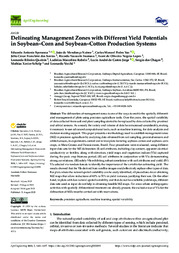Delineating management zones with different yield potentials in soybean-corn and soybean-cotton production systems.
Delineating management zones with different yield potentials in soybean-corn and soybean-cotton production systems.
Autoria: SPERANZA, E. A.; NAIME, J. de M.; VAZ, C. M. P.; FRANCHINI, J. C.; INAMASU, R. Y.; LOPES, I. de O. N.; QUEIROS, L. R.; RABELLO, L. M.; JORGE, L. A. de C.; CHAGAS, S. das; SCHELP, M. X.; VECCHI, L.
Resumo: Abstract: The delineation of management zones is one of the ways to enable the spatially differentiated management of plots using precision agriculture tools. Over the years, the spatial variability of data collected from soil and plant sampling started to be replaced by data collected by proximal and orbital sensors. As a result, the variety and volume of data have increased considerably, making it necessary to use advanced computational tools, such as machine learning, for data analysis and decision-making support. This paper presents a methodology used to establish management zones (MZ) in precision agriculture by analyzing data obtained from soil sampling, proximal sensors and orbital sensors, in experiments carried out in four plots featuring soybean-cotton and soybean-corn crops, in Mato Grosso and Paraná states, Brazil. Four procedures were evaluated, using different input data sets for the MZ delineation: (I) soil attributes, including clay content, apparent electrical conductivity or fertility, along with elevation, yield maps and vegetation indices (VIs) captured during the peak crop biomass period; (II) soil attributes in conjunction with VIs demonstrating strong correlations; (III) solely VIs exhibiting robust correlation with soil attributes and yield; (IV) VIs selected via random forests to identify the importance of the variable for estimating yield. The results showed that the VIs derived from satellite images could effectively replace other types of data. For plots where the natural spatial variability can be easily identified, all procedures favor obtaining MZ maps that allow reductions of 40% to 70% in yield variance, justifying their use. On the other hand, in plots with low natural spatial variability and that do not have reliable yield maps, different data sets used as input do not help in obtaining feasible MZ maps. For areas where anthropogenic activities with spatially differentiated treatment are already present, the exclusive use of VIs for the delineation of MZs must be carried out with reservations.
Ano de publicação: 2023
Tipo de publicação: Artigo de periódico
Unidade: Embrapa Agricultura Digital
Observações
1 - Por padrão são exibidas publicações dos últimos 20 anos. Para encontrar publicações mais antigas, configure o filtro ano de publicação, colocando o ano a partir do qual você deseja encontrar publicações. O filtro está na coluna da esquerda na busca acima.
2 - Para ler algumas publicações da Embrapa (apenas as que estão em formato ePub), é necessário ter, no celular ou computador, um desses softwares gratuitos. Sistemas Android: Google Play Livros; IOS: iBooks; Windows e Linux: software Calibre.
Acesse outras publicações
Acesse a Base de Dados da Pesquisa Agropecuária (BDPA) para consultar o acervo completo das bibliotecas da Embrapa.

